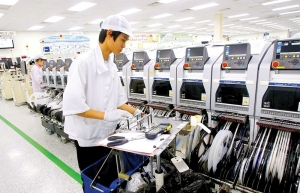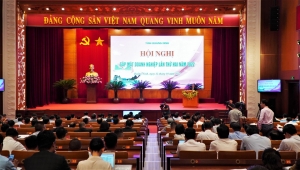Roadblocks hit trajectory for newly-registered capital
Statistics published by the Foreign Investment Agency (FIA) under the Ministry of Planning and Investment showed that in the first nine months of the year, there were 1,355 newly-registered projects with the total registered capital of $7.12 billion, up 11.8 per cent in the total number of projects but down 43 per cent in capital.
 |
| Roadblocks hit trajectory for newly-registered capital, Source: Shutterstock |
The FIA attributed several reasons to this reduction. State policies on controlling the pandemic and the halt of international flights caused barriers for investors to visit Vietnam to explore opportunities and fulfil registration procedures in the last months of 2021.
Nguyen Xuan Phuong, director of Vinh Phuc Industrial Parks Management Authority told VIR, “People are cautious with their investments overseas, especially in large-scale projects, and prefer conducting field surveys and studying potential opportunities. Investor travel restrictions between countries interrupted their investment decision-making process.”
According to the FIA, in January and February, the percentage of on-year reduction in newly-registered capital was 70.7 and 80.9 per cent, respectively.
The agency judged that the global market has been facing fluctuations due to the geopolitical conflict in Europe, high inflation pressure, and supply chain disruptions, which have been negatively affecting the outflow of foreign investment from major economies, especially investment partners of Vietnam.
The World Investment Report 2022 published by the United Nations Conference on Trade and Development indicates that foreign direct investment (FDI) recovered to pre-pandemic levels in 2021, reaching nearly $1.6 trillion, but this is unlikely to be sustained in 2022.
“We forecast that the growth momentum of 2021 cannot be sustained and global FDI flows in 2022 will likely move downward, at best remaining flat,” the report said. “However, even if flows should remain relatively stable in value terms, new project activity may suffer from investor uncertainty.”
This year, the business and investment climate has changed dramatically as the war in Ukraine resulted in a triple crisis of high food and fuel prices as well as tighter financing. Other factors impacting FDI were the renewed pandemic impact, the likelihood of more interest rate rises, negative sentiment in financial markets, and potential recession.
Despite high profits, investments by multinational companies in new projects overseas accounted for one-fifth compared to pre-pandemic levels last year.
Signs of weakness are already emerging this year. Preliminary data for the first quarter showed greenfield project announcements down 21 per cent globally, cross-border merger and acquisition activity down 13 per cent, and international project finance deals down 4 per cent.
According to an HSBC report from June, Vietnam is consistently one of the top receivers of FDI relative to GDP in ASEAN, thus the decrease in newly-registered capital in the country is understandable.
The FIA also mentioned a lack of large-scale projects worth over $100 million in the first nine months compared to 2021 as one of the major issues. Notably, the Long An 1 and 2 liquefied natural gas power projects worth over $3.2 billion and $1.3 billion, respectively, and the O Mon II thermal power plant contributed 62.3 per cent of the newly-registered capital in the first three quarters of 2021.
In the first nine months of this year, the total of foreign-invested projects with a scale of over $100 million made up 37.2 per cent compared to the registered investment inflow for this period. The $1-billion Lego factory announcement was a rare bright spot.
“These simple comparisons show the vital role of large-scale projects in boosting foreign-invested capital inflow and newly-pledged investment capital,” said Nguyen Huu Toan, vice chairman of the Vietnam’s Association of Foreign-Invested Enterprises.
In the first three quarters of this year, the new registration of foreign-invested projects declined on year. However, there are still positives. Notably, the rate of reduction has declined for several consecutive months.
For example, in February, the percentage of on-year reduction was 80.9 per cent, while in March it was 55.5 per cent. The percentage of on-year reduction was down from 56.3 per cent in April to 43 per cent in September.
Furthermore, according to the FIA, the total volume of newly-registered projects in September increased by 6.8 per cent compared to August and 46.2 per cent compared to July.
 | Spillover FDI effects require levelling up The high share of foreign direct investment in Vietnam’s export turnover, as well as the minor participation of local suppliers, is a warning sign for many macroeconomic experts who advise reducing the dependence on foreign markets and strengthening domestic enterprises in favour of a more sustainable development strategy. |
 | Disbursement figures reflect bearish economic projections The socioeconomic situations over the world, along with the efforts of Vietnam to build a competitive and transparent business climate, have contributed to enabling foreign direct investment (FDI) disbursement to its highest peak ever. |
 | Quang Ninh issues series of commitments to attract investors Quang Ninh People’s Committee will implement seven commitments to attract investors and simultaneously support the business community to expand operations. |
What the stars mean:
★ Poor ★ ★ Promising ★★★ Good ★★★★ Very good ★★★★★ Exceptional
Related Contents
Latest News
More News
- Global partnerships key to Vietnam’s IFC development (December 26, 2025 | 16:18)
- Vingroup pulls out of bid to invest in North-South high-speed railway (December 26, 2025 | 11:42)
- Strengthening supply chains through trade promotions and customs reform (December 24, 2025 | 14:00)
- PM orders investment model for North–South high-speed rail (December 22, 2025 | 17:43)
- LS Eco Energy to invest in Vietnam rare earth sector (December 22, 2025 | 17:31)
- Government moves to establish International Financial Centre (December 21, 2025 | 21:00)
- Vietnam's IFC to target global investment flows (December 21, 2025 | 18:00)
- Two national hospitals expand capacity with new facilities (December 20, 2025 | 09:00)
- Ha Tinh breaks ground on major Vingroup industrial and energy projects (December 19, 2025 | 18:24)
- EVN launches major power infrastructure projects nationwide (December 19, 2025 | 18:17)

 Tag:
Tag:





















 Mobile Version
Mobile Version